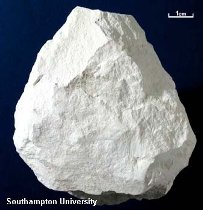Chalk and sandstone cliffs, Norfolk
 Image to left: chalk hand specimen
Image to left: chalk hand specimenImage below: tiny shells of chalk plankton seen with an electron microscope
 Sedimentary rocks contain layers that can be clearly seen when the layers have different colours. In the photograph below, orange-coloured sandstone at the cliff foot has red sandy chalk above it, and almost pure white Chalk on top.
Sedimentary rocks contain layers that can be clearly seen when the layers have different colours. In the photograph below, orange-coloured sandstone at the cliff foot has red sandy chalk above it, and almost pure white Chalk on top.These layers of rock show a rise in global sea-level that occurred about 100 million years ago. The shallow-water, in which iron-rich sands were deposited was followed by deeper clear warm seas in which tiny marine organisms (plankton) lived. These died and fell to the bottom as fine white mud that eventually became the fine limestone that we call Chalk.
The cliffs and boulders contain fossil remains of the creatures that lived in these seas, including shells, sea-urchins and ammonites, as well as preserved burrows of creatures that lived in the sea-floor sediment.
Hunstanton cliffs, Norfolk








